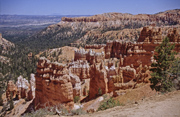Sedimentary Rocks
Formation
For thousands, even millions of years, little pieces of our earth have been eroded--broken down and worn away by wind and water. These little bits of our earth are washed downstream where they settle to the bottom of the rivers, lakes, and oceans. Layer after layer of eroded earth is deposited on top of each. These layers are pressed down more and more through time, until the bottom layers slowly turn into rock.
Hover over the images to enlarge.
Coal
 It is an organic sedimentary rock that forms from the accumulation and preservation of plant materials, usually in a swamp environment. Coal is a combustible rock and along with oil and natural gas it is one of the three most important fossil fuels.
It is an organic sedimentary rock that forms from the accumulation and preservation of plant materials, usually in a swamp environment. Coal is a combustible rock and along with oil and natural gas it is one of the three most important fossil fuels.
Dolomite
 It is a carbonate mineral composed of calcium magnesium carbonate CaMg(CO3)2. The term is also used to describe the sedimentary carbonate rock dolostone. Vast deposits are present in the geological record, but the mineral is relatively rare in modern environments.
It is a carbonate mineral composed of calcium magnesium carbonate CaMg(CO3)2. The term is also used to describe the sedimentary carbonate rock dolostone. Vast deposits are present in the geological record, but the mineral is relatively rare in modern environments.
Flint
 It is a hard, sedimentary cryptocrystalline form of the mineral quartz, categorized as a variety of chert. It occurs chiefly as nodules and masses in sedimentary rocks, such as chalks and limestones. Inside the nodule, flint is usually dark grey, black, green, white, or brown in colour, and often has a glassy or waxy appearance. A thin layer on the outside of the nodules is usually different in colour, typically white and rough in texture.
It is a hard, sedimentary cryptocrystalline form of the mineral quartz, categorized as a variety of chert. It occurs chiefly as nodules and masses in sedimentary rocks, such as chalks and limestones. Inside the nodule, flint is usually dark grey, black, green, white, or brown in colour, and often has a glassy or waxy appearance. A thin layer on the outside of the nodules is usually different in colour, typically white and rough in texture.
Limestone
It is a sedimentary rock composed largely of the minerals calcite and aragonite, which are different crystal forms of calcium carbonate. Many limestones are composed from skeletal fragments of marine organisms such as coral or foraminifera. Limestone makes up about 10% of the total volume of all sedimentary rocks.
![]() Coniston Limestone is from around Coniston in the English Lake District, and forms part of the Windermere Supergroup. It is late Ordovician or possibly early Silurian in age and rests unconformably upon the Borrowdale Volcanic Group of rocks, which subsided beneath the sea, after the volcanic period. Since the seas that gave rise to these deposits were teeming with life, there are fossils.
Coniston Limestone is from around Coniston in the English Lake District, and forms part of the Windermere Supergroup. It is late Ordovician or possibly early Silurian in age and rests unconformably upon the Borrowdale Volcanic Group of rocks, which subsided beneath the sea, after the volcanic period. Since the seas that gave rise to these deposits were teeming with life, there are fossils.
![]() Tufa is a variety of limestone, formed by the precipitation of carbonate minerals from ambient temperature water bodies. Geothermally heated hot-springs sometimes produce similar (but less porous) carbonate deposits known as travertine. Tufa is sometimes referred to as (meteogene)travertine.
Tufa is a variety of limestone, formed by the precipitation of carbonate minerals from ambient temperature water bodies. Geothermally heated hot-springs sometimes produce similar (but less porous) carbonate deposits known as travertine. Tufa is sometimes referred to as (meteogene)travertine.
![]() Oolitic Limestones are whitish to cream-colored limestones composed of sand-sized (1/16 to 2 mm in size), well rounded, concentrically-layered calcite or aragonite grains called oolites. Oolites form by rolling back and forth on a shallow seafloor, or sometimes on a shallow lake bed, by wave action.
Oolitic Limestones are whitish to cream-colored limestones composed of sand-sized (1/16 to 2 mm in size), well rounded, concentrically-layered calcite or aragonite grains called oolites. Oolites form by rolling back and forth on a shallow seafloor, or sometimes on a shallow lake bed, by wave action.
Sandstone
 (sometimes known as arenite) is a clastic sedimentary rock composed mainly of sand-sized minerals or rock grains. Most sandstone is composed of quartz and/or feldspar because these are the most common minerals in the Earth's crust. Like sand, sandstone may be any colour, but the most common colours are tan, brown, yellow, red, gray, pink, white and black.
(sometimes known as arenite) is a clastic sedimentary rock composed mainly of sand-sized minerals or rock grains. Most sandstone is composed of quartz and/or feldspar because these are the most common minerals in the Earth's crust. Like sand, sandstone may be any colour, but the most common colours are tan, brown, yellow, red, gray, pink, white and black.

